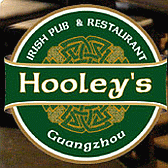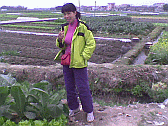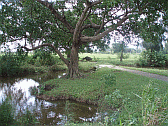|
|
| Chinese
History |
Neolithic
Cultures
|
|
Early Times
This era represents earliest human pre-history, and
times of myths and legends - perhaps a time when Dragons
walked the earth and flew the skies? Many modern Chinese
still talk about these legends today = so just mention
The Yellow Emperor ‘Huang Di’, if you want
to start an animated discussion. This would be very
similar to Britons and Celts talking about King Arthur–
only Huang Di lived about 6 millennia earlier, and did
exist in real life!
This also represents the change from hunter/gatherers
who used simple stone and wooded tools: to times of
settlement, farming, and the use of metals. Language
in the modern sense is invented and recorded for the
first time, and ceramic ware also comes into being,
plus making fire has become easy. Some of these events
were written down many millennia later, and until recently
have been regarded as having no factual basis. However,
recent archaeological discoveries have confirmed the
existence of Huang Di and his contemporaries, Yan Di
and Chi You
China is one of the oldest world civilisations still
in existence, and can trace direct ancestry back to
neolithic times and the Old Stone Age. Historians
most notably focus on the Yellow River people of Circa
5, 000 BC (Also the nearby Yangtze River People),
and quote these as being a small unassociated groups.
Here is what was really happening:
Pre-Chinese Cultures
Early Chinese tribes from after the ice age to before
the dawn of the modern empires (Circa 10, 000 - 3, 000
BC) are amalgamated from a small area of land between
Xi'an in the west and Beijing in the east. They are
based in the area bounded by the \Yellow River to the
north, and the Yangtze River to the south. This is a
very small area on the global map.
What our own research indicates, which no scholars are
apparently picking-up upon, is that countless hordes
of new tribes seem to generate from the North of China's
borders - continuously! We would arbitrarily place this
point of inception around Lake Baikal in Russia, and
to the East.
What you will find is that all these 'new' tribes head
South, and most flounder when meeting northern China.
In the earliest days, some could progress east a little,
but basically everybody else had to either go west or
become extinct. This appears to be the case because
even more new tribes were continuously heading down
from the North over millennia.
All over the world, people gathered in small groups
and clans. Some became larger. They battled for survival
on a daily basis, and had to defend themselves from
animal predators, and other clans. Slowly an order develops
out of the chaos, and then expansion. In China the first
records are of 8-groups:
1. Yangshao culture  (5000-3000 BC), finds stretch from the Yellow River
(5000-3000 BC), finds stretch from the Yellow River
 plain in the east into Gansu, and are mainly centred
upon Hunan Province
plain in the east into Gansu, and are mainly centred
upon Hunan Province
2. East to the Yangshao communities
the Dawenkou culture  (5000-3000 BC) was located, in modern Shandong Province
(5000-3000 BC) was located, in modern Shandong Province
3. In the lower Yangtze  area we find three distinctive cultures:
area we find three distinctive cultures:
a) Majiabang  (5000-3500 BC)
(5000-3500 BC)
b) Hemudu  (5000-3500 BC)
(5000-3500 BC)
c) Qingliangang  (4500-3000 BC) .
(4500-3000 BC) .
d) The existence of these three cultures proves that
civilisation was not means confined to the Yellow
River plain. They were also consecutive, meaning they
developed out of each other in some ways.
4. In the middle Yangtze valley the
Daxi  and
Qujialing and
Qujialing  cultures (5000-3000 BC) are located.
cultures (5000-3000 BC) are located.
5. Far in the south, including sites
in Taiwan, was the region of the Dapenkeng culture
 (5000-2500 BC)
(5000-2500 BC)
6. In northern China, in the Liao
River basin  ,
three successive cultures occupied this once fertile
area: ,
three successive cultures occupied this once fertile
area:
a) Xinglongwa  (8500-7000 BC)
(8500-7000 BC)
b) Xinle  (7000-5000 BC)
(7000-5000 BC)
c) Hongshan  (3000-2500 BC).
(3000-2500 BC).
d) These cultures were the first to make intensive
use of jade as workable material, carved with dragon
motifs.
Nb. Yes, I only count six or
eleven as well - Here is China!
Here is another version, again supplied by Wikipedia
http://en.wikipedia.org/wiki/List_of_Neolithic_cultures_of_China
| Dated |
English name |
Chinese name |
Modern-day location |
| 7500 BCE – 6100 BCE |
Pengtoushan culture |
 |
Central Yangtze River region
in northwestern Hunan |
| 7000 BCE – 5000 BCE |
Peiligang culture |
 |
Yiluo River valley in Henan |
| 6500 BCE – 5500 BCE |
Houli culture |
 |
Shandong |
| 6200 BCE – 5400 BCE |
Xinglongwa culture |
 |
Inner Mongolia-Liaoning border |
| 6000 BCE – 5500 BCE |
Cishan culture |
 |
Southern Hebei |
| 5800 BCE – 5400 BCE |
Dadiwan culture |
 |
Gansu and western Shaanxi |
| 5500 BCE – 4800 BCE |
Xinle culture |
 |
lower Liao River on the Liaodong
Peninsula |
| 5400 BCE – 4500 BCE |
Zhaobaogou culture |
 |
Luan River valley in Inner Mongolia
and northern Hebei |
| 5300 BCE – 4100 BCE |
Beixin culture |
 |
Shandong |
| 5000 BCE – 4500 BCE |
Hemudu culture |
 |
Yuyao and Zhoushan, Zhejiang |
| 5000 BCE – 3000 BCE |
Daxi culture |
 |
Three Gorges region |
| 5000 BCE – 3000 BCE |
Majiabang culture |
 |
Taihu Lake area and north of
Hangzhou Bay |
| 5000 BCE – 3000 BCE |
Yangshao culture |
 |
Henan, Shaanxi, and Shanxi |
| 4700 BCE – 2900 BCE |
Hongshan culture |
 |
Inner Mongolia, Liaoning, and
Hebei |
| 4100 BCE – 2600 BCE |
Dawenkou culture |
 |
Shandong, Anhui, Henan, and Jiangsu |
| 3400 BCE – 2250 BCE |
Liangzhu culture |
 |
Yangtze River Delta |
| 3100 BCE – 2700 BCE |
Majiayao culture |
 |
Upper Yellow River region in
Gansu and Qinghai |
| 3100 BCE – 2700 BCE |
Qujialing culture |
 |
middle Yangtze River region in
Hubei and Hunan |
| 3000 BCE – 2000 BCE |
Longshan culture |
 |
Central and lower Yellow River |
| 2800 BCE – 2000 BCE |
Baodun culture |
 |
Chengdu Plain |
| 2500 BCE – 2000 BCE |
Shijiahe culture |
 |
Middle Yangtze River region in
Hubei |
| 2100 BCE – 1500 BCE |
Erlitou culture |
 |
Yanshi, Henan Province |
Note:
1. This above all relates to what we would consider
to be cultures of the Middle-Yangtze River.
2. Contemporary cultures also are recorded in Southeastern
China, and known for their ‘Corded Ware’
– which did not arrive in Europe until millennia
later.
3. If you look Southwest, then you will find the Bon
culture of Tajikistan, Kashmir and Tibet.
4. Modern ChongQing (Probably the largest city on
earth today) has relics dated to this era also, but
different ancestry of course. China is a very big
place!
Let’s be specific:
The oldest documented civilisation from China is in
fact the ‘xinglongwa’ or ‘Xing Long
Wa’ from ’Northern China’. The modern
meaning of the Chinese characters  would mean ‘Rising from glorious depth’,
which could mean a transformed Carp (Carp can become
Dragons btw [By The Way]). This would be fine for
Mandarin speaking historians replicating pre-history
in modern Chinese character conception.
would mean ‘Rising from glorious depth’,
which could mean a transformed Carp (Carp can become
Dragons btw [By The Way]). This would be fine for
Mandarin speaking historians replicating pre-history
in modern Chinese character conception.
My reading is that these people already consider themselves
to be descendents of ‘The Dragon’. This
is a type of Cantonese I know today, and means ‘People
of the Star Dragon Tongue!’ or similar
– Simple and obvious! The sounds mean this,
and the later applied Chinese characters are wrong,
especially because they are the first people to carve
jade into dragons; therefore ‘Long’ means
Dragon, and cannot mean anything else! Wa = wah, and
means ‘talking’ and most likely ‘tongue’.
Xing means star. This is all daily spoken Cantonese
on the streets of Foshan in 2009 .  is my personal translation of the correct characters
for this tribe
is my personal translation of the correct characters
for this tribe
http://www.chinaknowledge.de/History/Myth/prehistory-event.html
Population Movement:
In The British Isles, it is a common perception that
most invasions come from the East and sometimes South
– thereby pushing the existing population North
or Westwards. I believe this is a fairly correct generalisation.
In China, the general and similar trend is invasion
from the North, thus pushing existing peoples further
south, and eventually Westwards (Due mainly to terrain
and the Pacific Ocean)
Before Empire
Lets assume that between 10, 000 BC (The end of the
last Ice Age and Neolithic Period) and documented
history, much of China consisted of secular clans
and warring states. It is a human preoccupation, and
quite a reasonable assumption. People would also gather
at the best known good places, which perhaps gave
rise to The Yellow River Peoples, amongst others.
1. Around this time, the Chinese Tiger and Alligator
were responsible for many human deaths and feared.
Rivers were also infested with highly poisonous snakes,
whilst sometimes other animals such as the Chinese
Elephant (Now virtually extinct with less than 300
left in the wild) would invade for resources, of which
the human fields and sheltering trees were excellent
fodder. Daily and annual survival was key thinking
2. Plant and animal husbandry was complicated, as
there were no predictions for 10-yearly floods or
tidal surges.
3. When not fighting, they would be trading and gaining
in knowledge
Meanwhile, others with different cultures and beliefs
would pass by, seeking new and virgin lands to make
their own; as would others break away. Times of flux
and uncertainty for all, so what changed?
The ice sheets receded, the oceans rose, and the weather
got warmer.
Do not think that people stopped moving around. Otherwise
how would you explain that the flags of modern day South
Korea and South Vietnam have Bagua inscriptions; or
the more universal Yin and Yang symbol?
The basic human drive is to live as well as practicably
possible, and grow as a family, and by extension - grow
as a tribe or village. Early cultures are far more vulnerable
than modern ones, with scarcity of food, natural disasters,
and animal predators all being of great concern. Therefore
it is rational to suppose some tribes would die out,
whilst others moved, grew, and/or forged new alliances
with similar groups. The names we know them by today
may be unreliable, and archaeologists tend to treat
all new finds as separate occurrences, and do not look
for links to other civilisations.
What does become apparent is that some of these tribal
groups took control of good areas of land and settled
in fixed communities where farming became the norm.
This does not mean they stopped all forms of hunter-gathering,
but that the emphasis shifted to sustainable crops.
Becoming settled in one location also brings advances
in technology and military discoveries. Associated with
this comes the rise of powerful warlords and turf wars.
The period is now 5, 000 BC; and the first Chinese Dynasty
is soon to be created by Huang Di in the fertile valley
of the Yangtze River east of modern day Xi'an.
We will therefore continue this study in our next chapter
'Huang Di', before
beginning documented Chinese history with the Xia Dynasty
circa 3, 000 BC.
China
Expats Quiz
In modern China others have a similar but different
views, as passed down to them from their families
and culture. Below is a current version from my friend
in Xi’an, who lists her top 10 Events of Chinese
history as follows.
This is Mindy’s version:
1. Pangu separated the heaven and the earth from
chaos
2. Nvwa, the Goddess with fish tail creates human
beings and patched the Sky
3. Shennong (Yan Emperor) initiated Chinese Agriculture
4. Yu the Great subdued the flood and created the
first dynasty in Chinese history and his son, Qi,
became the first king
5. Qin Shi Huang unified law, currency and characters,
built the first imperial dynasty and was the first
emperor in China
6. Wu Zetian, the first and the only women emperor
in Chinese history. Yes, powerful Tang is an open
dynasty and Tang people are also open, I think.
7. Genghis khan leaded his strong army expanded Yuan's
territory to Europe.
8. The construction of the Great Wall and Forbidden
City gave us the most fatuous treasure
9. You know what did Chairman Mao do, right? :-)
10. My mother gave birth to me 24 years ago. :-) (just
for fun)
|
|
This
information is as supplied by Wikipedia, as dated March
2009 or later, and/or other reliable sources.
Maps (Unless stated otherwise)
are provided in association with Thomas Lessman
Web: www.worldhistorymaps.info
Disclaimer:
Please check this information yourself as it may alter
without notice, and whilst we try our best to ensure
it is correct, please do not hold us responsible for
any errors - this is intended as a simple guide only |
|
| Search
this Website |
|
|
| Our
Friends |
Excellent
& Free Online Chinese Language Portal

Thousands of free print-friendly Chinese reference sheets,
tests and revision aids.
Easy Learning format &
Listen to Spoken Words |

Professional
Visa Services
Company
Formation Packages
.
|

British Foreign Office
Resource and Advice for Travellers Worldwide |

Chinese Embassy in UK
Information About China
International Relations
Visa & Consular |

UK Embassy in China
Information About UK
International Relations
Visa & Consular |

|
Excel
Education |
Languages Courses
Study Abroad
Employability
Summer Camps
Information for Teachers |
|

Excellent and relaxing base to
explore this most beautiful of regions in all China! |
Down The Road.org
How We Traded Our Ordinary Lives For a Global Bicycle Touring Adventure

See
Us in China |

Empowering Underprivileged Children
& Their Communities = Worldwide |
 |

Based in Shangri-la,
Yunnan
Province
Dedicated to Exploring Remote Areas of China
Committed to Nature Conservation and Preserving Ethnic
Cultures & Traditions
|

Based in Xi'an,
China's Premiere Travel Agency and International Travel
Community -
Committed to providing:
Best travel deals & current information for all
International Travellers |

Pearl Dragon
Vast
Online Trading and Information Resource
Link goes to Chinese Tourism and Galleries Section |
| Canton
Caddywack |


|
|